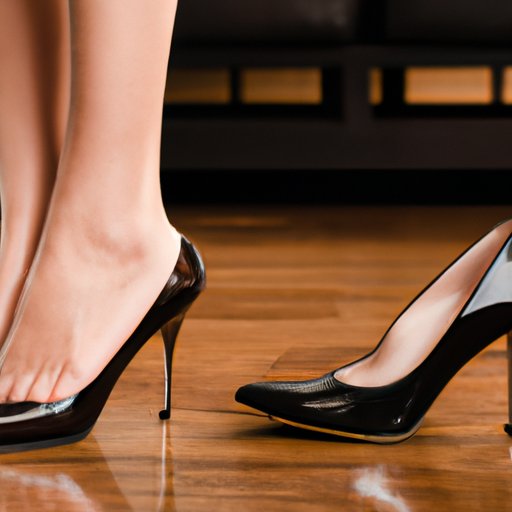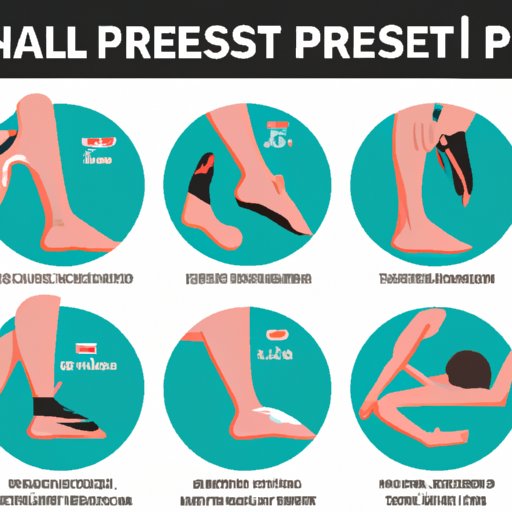Introduction
If you’ve ever experienced a sharp pain in your heels while walking, then you know how debilitating it can be. Heel pain is one of the most common reasons people seek medical attention for foot-related issues. But why do your heels hurt when you walk? The answer to this question can vary depending on a range of factors. In this article, we’ll explore the seven common causes of heel pain and provide advice on how to treat them. We’ll also discuss the importance of proper footwear and provide tips for preventing and alleviating heel pain through exercises and stretches.
7 Common Causes of Heel Pain with Walking and How to Treat Them
Plantar Fasciitis
Plantar fasciitis is a condition that occurs when the plantar fascia, the thick band of tissue that runs along the bottom of your foot, becomes inflamed. This can lead to a sharp pain in your heel, especially when putting weight on your foot. Common causes of plantar fasciitis include overuse, improper footwear, and tight calf muscles.
To treat plantar fasciitis, doctors may recommend stretching exercises, wearing supportive shoes, and using specialized shoe inserts. Nonsteroidal anti-inflammatory drugs (NSAIDs) or corticosteroid injections may also provide relief for severe cases.
Heel Spurs
Heel spurs are bony protrusions that develop on the heel. They often occur at the point where the plantar fascia attaches to the heel bone. People with flat feet or high arches are at higher risk for developing heel spurs. Symptoms can include pain, swelling, and difficulty walking.
Treatment options for heel spurs include using ice to reduce swelling, taking NSAIDs, and wearing padded shoe inserts. In severe cases, surgical removal of the heel spur may be necessary.
Achilles Tendinitis
Achilles tendinitis occurs when the tendon that connects your heel bone to your calf muscle becomes inflamed. Causes can include overuse, improper footwear, and a sudden increase in activity level. Symptoms of Achilles tendinitis can include pain, swelling, and stiffness in the ankle.
To treat Achilles tendinitis, doctors may recommend rest, physical therapy, corticosteroid injections, or surgery for severe cases. It’s also important to wear supportive footwear and avoid activities that put undue stress on the tendon.
Tarsal Tunnel Syndrome
Tarsal tunnel syndrome is a condition that results from the compression of the posterior tibial nerve, which runs through a narrow passage in the ankle. The condition can cause pain, numbness, and tingling in the heel and foot. Common causes include injury, arthritis, and flat feet.
To treat tarsal tunnel syndrome, doctors may recommend wearing supportive shoes, taking NSAIDs, and undergoing physical therapy. In severe cases, surgical decompression of the nerve may be necessary.
Stress Fractures
Stress fractures are small cracks that can develop in bones due to repetitive use. They’re common in the heel because of the amount of weight that’s placed on it when walking or running. Symptoms can include pain, swelling, and difficulty putting weight on the affected foot.
To treat a stress fracture, doctors may recommend wearing a supportive boot or cast, taking NSAIDs, and resting the affected foot. In severe cases, surgery may be necessary.
Bursitis
Bursitis occurs when the small sacs of fluid that cushion joints become inflamed. This can lead to pain and stiffness in the affected joint. In the heel, bursitis most commonly occurs in the retrocalcaneal bursa, located at the back of the heel bone.
To treat bursitis of the heel, doctors may recommend taking NSAIDs, using ice to reduce swelling, and avoiding activities that put undue stress on the affected joint. Wearing supportive shoes with heal padding can also help.
Severs Disease
Severs disease is a condition that occurs in children and adolescents when the growth plate in the heel bone becomes inflamed. Symptoms can include pain and tenderness in the heel, as well as difficulty walking or running.
To treat Severs disease, doctors may recommend taking NSAIDs, using ice to reduce swelling, and avoiding activities that put undue stress on the affected foot. Wearing supportive shoes with good heel padding and inserts can also be helpful.

The Importance of Proper Footwear: How Wearing the Wrong Shoes Could be Causing Your Heel Pain
Proper footwear is essential for preventing and alleviating heel pain. Ill-fitting or unsupportive shoes can exacerbate underlying foot conditions and cause excessive stress on the heel. To choose the right shoes for your feet, consider the following factors:
– Arch type: People with flat feet or high arches may require different types of shoes for optimal support.
– Activity level: Different activities require different types of shoes. Running shoes, for example, provide more support than casual sneakers.
– Foot shape: People with wide or narrow feet may need to choose shoes that accommodate their foot shape.
When shopping for shoes, make sure to try them on in store and walk around to see how they feel. The shoes should fit snugly but not feel tight or constricting. Look for shoes with good arch support and a cushioned sole to help distribute weight evenly across the foot.
Plantar Fasciitis: Understanding this Common Condition and How to Relieve Your Heel Pain
Causes, Symptoms, and Risk Factors of Plantar Fasciitis
Plantar fasciitis is a common condition that affects many people. It can be caused by a variety of factors including overuse, improper footwear, and tight calf muscles. Symptoms of plantar fasciitis include a sharp pain in the heel, especially when putting weight on the foot. Risk factors include being overweight, having flat feet or high arches, and being a runner or athlete.
How to Relieve the Pain
There are several ways to relieve the pain associated with plantar fasciitis. Stretching exercises that target the calf muscles and the plantar fascia can help relieve tension and improve flexibility. Massage can also provide relief by increasing blood flow to the affected area. Other treatments include using orthotic inserts in shoes, wearing night splints to stretch the foot while sleeping, and using NSAIDs to reduce inflammation.
Heel Spurs: What They Are, Causes, Symptoms, and Treatment Options
Causes and Symptoms of Heel Spurs
Heel spurs are bony protrusions that develop on the heel bone. They can cause pain and swelling in the affected area, as well as difficulty walking. Causes of heel spurs include overuse, flat feet, and high-impact activities like running or jumping.
Treatment Options
There are several treatment options for heel spurs. Using ice to reduce inflammation and taking NSAIDs can help alleviate pain. Physical therapy may also be useful for strengthening the muscles and improving flexibility. In severe cases, surgical removal of the heel spur may be necessary.
Injury Prevention: Tips for Avoiding Heel Pain While Walking or Running
Preventing injury is essential for avoiding heel pain while walking or running. Some tips for injury prevention include:
– Warming up before exercise
– Using proper running form, including landing on the midfoot rather than the heel
– Gradually increasing activity levels
– Choosing properly fitting shoes with good arch support and cushioned soles
Stretching and Strengthening Exercises to Alleviate Heel Pain
Stretching and strengthening exercises can help alleviate heel pain and improve flexibility and strength in the feet and ankles. Some exercises that may be helpful include:
– Calf stretches
– Rolling a tennis ball under the foot
– Toe raises
– Heel raises
– Ankle rotations
Talk to your doctor or physical therapist before starting any exercise program, especially if you have an existing foot condition.
When to Seek Professional Help for Chronic Heel Pain: Understanding the Signs and Symptoms
If you experience chronic heel pain, it’s important to seek professional medical help. Signs and symptoms that may indicate the need for medical attention include:
– Pain that persists for more than a few days
– Difficulty putting weight on the affected foot
– Swelling or redness in the affected area
– Numbness or tingling in the foot
Professional medical help may include physical therapy, medications, or in some cases, surgery.
Conclusion
Heel pain can be a debilitating condition that limits mobility and causes discomfort. However, by understanding the causes of heel pain and taking steps to prevent and treat it, you can alleviate symptoms and improve your overall foot health. Whether it’s plantar fasciitis, heel spurs, or another condition, there are a variety of treatment options available. By choosing proper fitting footwear, engaging in regular exercise, and seeking professional medical help when necessary, you can enjoy optimal foot health for years to come.
